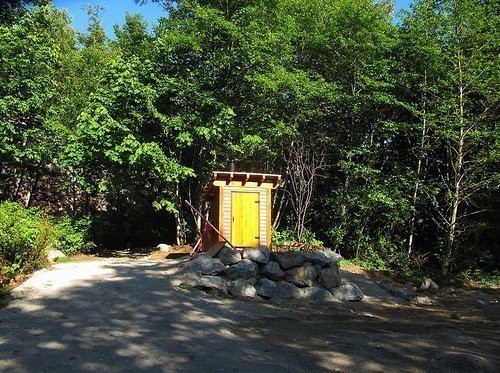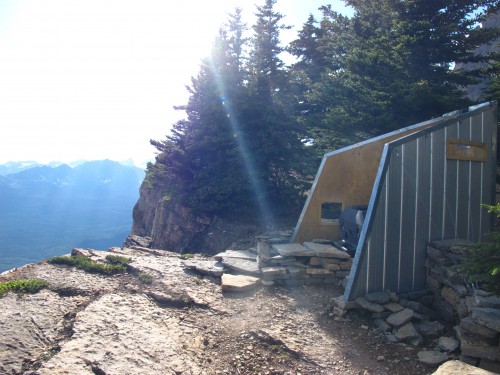Climbers and Pooping in the Mountains and Other Places

There is a lot of human waste where climbers play, in some places more than others.
We all go number two, a lot. Some of us more than once a day and some less than once a day. As the numbers of climbers increases, the number of back country poops increases.
In some places, it’s become a disgusting problem, while in others it is being managed in an appropriate and clean way. In the Smoke Bluffs in Squamish, a vermicomposting toilet project is taking place near the popular Penny Lane crag.
The Squamish Climate Action Network stated, “Vermicomposting toilets have been used widely in Europe, found to be odourless and environmentally friendly to the natural habitat.” It was installed by climber and president of Toilet Tech Solutions Geoff Hill.

Another example of where waste is being managed well is the Bugaboos. There are “custodians” who manage the Kain Hut during the busy season. One of their responsibilities is to change out the barrels under the outhouse on a regular bases. Helicopters swoosh the barrels away on a fixed schedule to a place where the waste it is disposed of properly. The process is perfected and the only thing that can go wrong is the tipping of a full barrel, which has happened more than once.
In Chamonix, the birth of alpine climbing, there are not many places to relieve yourself. The base of some popular routes have piles of human waste that become smelly in the sun. Many routes have cracks and ledges where you don’t want your rope to touch.
On Castle Mountain in the Canadian Rockies, there is a seat near a steep drop that looks out across the Bow Valley and Storm Mountain. It is near the Castle Mountain Hut. Read “Loo With A View” about the new age toilet here.

In Alaska, on Denali, climbers are issued Clean Mountain Cans (CMC), which they are required to use. As the park states, “The Clean Mountain Can is designed specifically for human waste in terms of size, weight, and strength.
“The durable CMC comes with a harness system that can lock the lid down and is sturdy enough to strap on a pack or sled.”
In 2013, top climber Conrad Anker and author Jon Krakauer were caught using the glacier as a toilet. The situation was resolved as their was an “emergency.” They helped clean up the mountain and have been involved in other organized clean-up projects. Read about what happened here.
At a number of crags across Canada, access organizations and parks have had toilets installed at or near crags. Pets can’t use toilets, so be sure to clean up after your crag pups.
Sometimes, as Jason Kruk found out, climbing offwidths can lead to pooping on a climb.
In the Himalaya, on Mount Everest, it is estimated there is 26,500 pounds of human waste each season. Most of it is put in bags and the Sherpas carry it to pits near Gorak Shep. Sherpa Pemba Nima said this about the dumping sites, “Pollution everywhere. Our main water source has been polluted.
“The dumping site is along the main trail to Everest Base Camp, sometimes our local animals (yaks) fall into the pit. Even though it has been moved to different location now, I think it takes so many years to disintegrate because of the cold climate the pollution will remain there for many years.”
Climber Mark Jenkins wrote in a National Geographic article, “The two standard routes, the Northeast Ridge and the Southeast Ridge, are not only dangerously crowded but also disgustingly polluted, with garbage leaking out of the glaciers and pyramids of human excrement befouling the high camps.”
On some remote routes, it’s fine to dig a hole in the snow. On Everest, climbers have been digging snow holes for poop for years. As they climb and acclimatize, there is no access to toilets. In 2015, before the deadly earthquake and avalanches, Ang Tshering, president of Nepal Mountaineering Association, warned that human waste has reached critical levels and threatens to spread disease on Everest.
In 2012, Grayson Schaffer, an editor for Outside magazine said, “Everest even has a sewage problem. When base camp’s outhouse barrels are filled, porters haul them to open pits near Gorak Shep.
“Meanwhile, above base camp, most climbers straddle small crevasses to relieve themselves. The result: The peak has become a fecal time bomb, and the mess is gradually sliding back toward base camp. In 2012, Swiss climber Ueli Steck told me that he won’t even boil snow for water at Everest’s Camp II, because he thinks the lower boiling temperature at that altitude won’t kill germs.”
Read “Peak Poop: The Feces Problem on Mount Everest Needs a Solution” by Brent Bishop for Outside magazine here.
In Yosemite, there have been a number of big wall poop issues. They are usually tied into the bigger-picture waste problems that popular routes suffer from. As they state on their website, “Go to the bathroom in a paper bag and then put that bag in some sort of container to carry off the cliff (a difficult process at hanging belays, but one that can be mastered with practice, determination, and flexibility).”
They go on to say, “What to use? Bottom line: use something, anything. Everyone has their own technique, but here are a few ideas to get you started:
“For the classic tube, attach screw caps to each end of a large PVC pipe. Glue one end shut, and tape on some webbing for easy hauling. Durable and reusable, but it takes time and a hardware store.
“If you’re short on time but not funds, commercial versions are available (check the Mountain Shop at Half Dome Village, formerly Curry Village). Dry bags work as well, and there are even a handful of commercial kits available to replace paper bags.
“If you’re short on time and funds, anything from a five-gallon bucket to reusable plastic containers can work in a pinch. These are durable, possibly reusable, and cheap.”
For those looking for a commercial product that helps with big wall pooping, check out the Metolius Waste Case.
How and where you go number two in the mountains is up to you. Hit the coffee shop and use the flushing toilets before you get to a crag. Use the outhouse at the crag if there is one. No matter what, always pack some toilet paper just in case. For those interested in waste bags, check out Cleanwaste, Biffy and ReStop.

Unbleached toilet paper breaks down faster than bleached. If you’re above tree line where the environment is delicate then dig a hole in the snow if you can and avoid peeing on vegetation. This can be tricky on steep slopes, but improvise and keep your gear clear of the fall zone. If you’re on a popular alpine route or big wall, pack it out.
In 2013, Evan Stevens wrote an article called “How To Poop On A Big Wall When You Have A Crush On Your Partner” in which he said, “There would be no making it back to the base first—I had to take a dump NOW! I quickly rapped down to the next small stance, two pitches above the ground, and yelled back up to Jasmin to wait for a few minutes. She was puzzled—I was mortified.” For the full story visit here.
In New Zealand, human waste has become a problem on the summit of Mount Taranaki, a 2,815-metre dormant volcano popular with climbers. The New Zealand Alpine Club is pushing for climbers to carry a Poo Pot. For more on the Poo Pot visit here.
Climbers eat a lot of food and poop often. Big scary climbs can throw our stomachs off and mess with our bathroom schedules. Be prepared for the worst, because there is nothing worse than being caught with your pants down unprepared.
Here is a helpful and entertaining video for how and where to poop on flatland:
The best practice is to pack it out, whether it is human or pet waste. Know your options and learn how to best stay clean and happy in the hills. There is more than one story about things getting messy for a climber.


